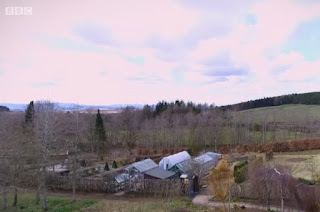
Carole Baxter welcomes us to Episode 4 of Beechgrove 2021 and introduces us to Mairi Rattray the Head Gardener who is helping her do some pruning and they are happy to have Brian Cunningham back in the garden after last weeks snow.
Mairi says there was no snow this week but it has been cold and dry and nice to see the sun is out today.
She is a little worried they have had no rain and the sun makes for more watering in the greenhouses.

Today they are giving some shrubs a spring tidy up and they are trimming a Mahonia x Media 'Charity' that has been in the garden for at least 25 years and in 2017 they featured Chris Beardshaw giving it a good trim.
It has now got very tall and is blocking out being able to see the rest of the border so with a good trim it will look better and will grow back and they will need a bow saw for the thick branches.
Presenters
Mairi Rattray

It flowers beautifully in the Winter and there still a trace of flowers on it now and the plant has put down a natural layer and it has set down its own rooted new shrubs.
Carole has already dug round and loosened the root ball on the new plant and all she has to do is sever the branch that it has grown from.
Now that it is free from the main plant she can finish digging it up and replant elsewhere in the garden.
Mairi Rattray
Mairi is also Spring pruning on a Macrophylla Mophead Hydrangea which means the flowers are produced on the wood from the previous year.
To get a good display she needs to keep a lot of the stems which have been protected by the old flowers over winter.
So she is just giving it a light trim down to a nice pair of new buds and any stems at the base if looking crowded.
The next Hydrangea Paniculata 'Vanille Fraise' is a different kind that has conical creamy white flowers in late Summer.
This one produces flowers on this years wood so it can take a hard pruning to about 60cm tall to create a wood framework and they will take an even harder prune.
She has some she has pruned back to just 40 cm tall and 25 cm as the harder you prune then the bigger the flowers they produce.
To see if that is true we will come back in the Summer to see how they got on.

Calum is at his water edge Allotment in Leven and today he is planting his carrots and tatties for shows.
First we get a tour of his Allotment plot at Silverburn Park and he has had the 47 foot x 25 foot plot since it first opened 4 years ago.

It is just 200 yards from the sea which is lovely when the weather nice but during the winter he puts a fence up to give them some protection.
His favourite spot on the Allotment is his polytunnel and he grows anything from Dahlias to oversized Onions all for shows.
He started gardening as a wee child in his gran and grandads garden and now they come and see him at his Allotment.

His Grandad helps him with the Show vegetables and his Gran is good at arranging it for the Show, a real family effort.
His Grandparents inspired him and he won his first show at just 15 years old and he hoping he can now pass that on to inspire others.
Calum says it is important to have a Graphic plan when gardening and it doesn't have to be as fancy as the one his sister has made him.
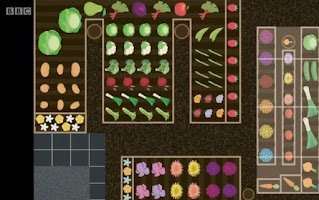
A plan good to keep you busy over Winter deciding where everything is going but also good for crop rotation the following year to see where you had produce planted.
His tatties are going in the front bed, 1 row to eat and 2 for the show and then 4ft giant Cabbages!
Then he has a flower bed at the side, Dahlia, Chrysanths and Gladioli. The back beds are for the Beans, Runners, French and Sweet Peas.

The polytunnel going to have Pot Leeks for the show, Dahlias, Onions, Tomatoes, Chrysanths and Stump Carrots and it was the Stump Carrots that won him his first show.
Calum in the Polytunnel and its nice and warm and he is showing us his Long Carrots first that is something new for him.
He has built the box they are in over the winter with his Grandad and they used recycled decking boards.
For the Stump Carrots he has a smaller box filled with sharp sand and it has been watered.
Calum uses a bit of drainpipe to sink half way into the box and pulls out the sand leaving a round hole in the sand.

He then uses a funnel he has made out of plant pots to sieve the carrot planting mixture into the hole, filling it level with the sand and places a stick in the middle so he knows where he is going to plant the seed.
Once the whole box is ready for planting and he takes out a stick, makes a hole and its ready for his carrot seed and Calum is planting 'Sweet Candle'.

Calum plants 3 seeds per hole to make sure one of them germinates and we will return to see his progress in a few weeks when the carrots will be thinned to just 1 per hole.
They will take 22 weeks to mature to show standard and they need to be lovely and round and a good tangerine orange colour.

Carole and Brian are on the main vegetable plot and they are having a competition with Brian growing Heritage Vegetables and Carole growing the modern F1 hybrids.
They have a basic plan drawn up as they are using crop rotation so there is not a build up of pests and diseases.
Brian for his Tattie planting is going no dig and he has laid old compost bags on the soil to warm it up for the last week.

He then cuts a slit in the compost bag and makes a hole to the depth of a trowel and plants the tattie with the eyes upwards.
Carole is using the more traditional approach of digging out a trench and with her measuring stick she is putting them 12 inches / 30 cm apart as they are earlies, 2nd earlies would be 40cm apart.
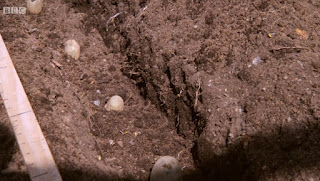
Carole modern variety is Casablanca which should be blight resistant and Brian is planting is Home Guard which has been around since 1942.
Back to Carole and Brian and this time it is Tatties (potatoes) in containers which is good if you do not have room to have them in the ground for 14 weeks.

They are also going to be testing different peat free composts they are growing them in.
The first compost is Wood fibre at 30p a litre then Wood fibre and Coir at 15p a litre, Wood fibre, Coir and Green compost is 30p per litre and finally Beechgrove's own compost at 0p a litre.
Brian questions where does Coir come from and Carole says it is a waste product but comes from the other side of the world!

They have also added an Organic fertiliser and they are growing the same variety of potato in each compost and its Premiere that they have not grown before.
They are also using 2 types of growing bags, potato bags you can buy anywhere and also old compost bags.
They put a bit of compost at the bottom and add the tubers about 3 in each bag and cover with compost.

As they grow in a few weeks time you just keep adding more compost.
In 14 weeks they will see which was the best growing method.

George is at home in sunny Joppa and he is showing us the seeds that have started to germinate that he sowed 2 weeks ago in his new raised beds with the glass tops.
In December he cut down his Cercidiphyllum, added a new fence and this has given them a chance to redo the border.
They can see the border from the window so they want it to look attractive and it is looking tired after being there for the last 18 years.

George has dug out some old plants and dug in fertiliser which is fish, blood and bone and it is now ready for the new plants.
He has ordered the plants from his local Garden Centre 'Click and Collect' and he has a Amsonia Blue Ice for the front of the bed.
He also has Rudbeckia Fulgida Early Bird Gold and has yellow daisy like flowers and he has 3 plants but instead of a clump they are going in a line.
For Autumn colour and height he has a grass Panicum Virgatum Prairie Sky which is a narrow grass which he is planting at the back.

At the back there are some Miscanthus he has divided from another plant in the garden and also some Calamagrotis taken from a plant in the front garden to plant.
It a good idea to have a look what you already have in the garden and can divide and repeat elsewhere in the garden and this also saves money.
George is hoping that by Autumn the revamped border will look 'spectacular'.

The ground is nice and soft as he has pre prepared and dug it so its easy to dig for the planting.
The Rudbeckia has a wonderful healthy root system that George teases out a bit before planting.
When he planted his final plant they will all get a good water.
Lucy Dalgleish

Beechgrove has been visiting Lucy for several years to look at what she is growing on her balcony in Maryhill.
This time it is her partner Stewart filming at their home on the edge of the Forth & Clyde Canal in Glasgow.
The flat balcony is south facing but Lucy still suffers from leggy seedlings occasionally and this year she also has an allotment so she wants to grow as many plants as possible.
So this year she has added a 'wee wonky greenhouse' and she has had it several years and only cost £15 but she has put it indoors after it was given a good clean.
By adding some grow lights they are doing the job and there will be less leggy seedlings and the lights cost about £30.
This time it is her partner Stewart filming at their home on the edge of the Forth & Clyde Canal in Glasgow.
The flat balcony is south facing but Lucy still suffers from leggy seedlings occasionally and this year she also has an allotment so she wants to grow as many plants as possible.
So this year she has added a 'wee wonky greenhouse' and she has had it several years and only cost £15 but she has put it indoors after it was given a good clean.
By adding some grow lights they are doing the job and there will be less leggy seedlings and the lights cost about £30.
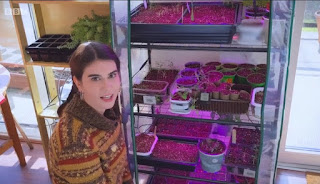
She also has some Foxgloves and in the spaces between her seedlings she has pots of Supermarket herbs, mint, parsley which are doing well in the humidity.
A supermarket bargain was her Hydrangea that she bought for just £1 the day after Mothers day so keep an eye on seasonal plants and bargains.
It is happy outside in the sunny weather but will be taken in when the frost starts.
Lucy says the one rule of Supermarket plants buying is there only short term plants usually in the shops.
Lucy says her goodbyes and that they will return in the Summer to see her Balcony when its at its best.
Handy Hints of the week
George is in the greenhouse and at the end of April is time to sow Courgettes and Pumpkins.
The Pumpkin variety is Crown Prince and the Courgette seed is a dwarf variety Aurelia which he is sowing first.

He places 1 seed per pot on its edge then presses them an inch deep into the soil.
These will germinate and be ready the end of May beginning of June to plant out.
Brian when your fruit trees, apples, plum and pear are starting to burst into life it is now the time to give them a feed and a mulch.
He has a high Potassium feed of Blood, Fish and Bone which he scatters at the base of each tree.
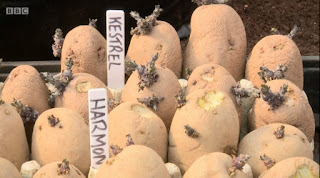

These will germinate and be ready the end of May beginning of June to plant out.
Brian when your fruit trees, apples, plum and pear are starting to burst into life it is now the time to give them a feed and a mulch.
He has a high Potassium feed of Blood, Fish and Bone which he scatters at the base of each tree.
After a good water he applies a 5cm layer of Mulch.
Calum hint is about growing exhibition potatoes and the chits need to be just 2 so you get bigger potatoes which he is growing in a bag with holes in so the roots can expand out of it.

The bag has a soft skin so it does not damage the potatoes and the first few weeks they are in the poly tunnel before planting outside.

Mairi ends the programme showing them the trimmed Mahonia and Carole and Brian like it as there still loads of new growth.

No comments:
Post a Comment